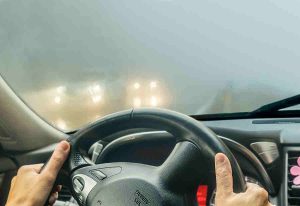7 Tips For Driving In Fog
 Michael Babboni
Car Accidents
Trucking Accidents
Driving in a fog can be one of the most dangerous weather hazards to drive in, especially if it is exceptionally dense fog or combined with sever other adverse weather conditions. In fact, foggy conditions are the number one cause of large multi car pile ups. However, there are a few things you can do to reduce your risk crash.
Michael Babboni
Car Accidents
Trucking Accidents
Driving in a fog can be one of the most dangerous weather hazards to drive in, especially if it is exceptionally dense fog or combined with sever other adverse weather conditions. In fact, foggy conditions are the number one cause of large multi car pile ups. However, there are a few things you can do to reduce your risk crash.1) Avoid Subconscious Habits!
During dense fog, something scary can happen to drivers. They unknowingly speed up! This is the worst thing you can do. However, it can be hard to avoid because you are normally used to driving at certain speeds, having to purposely drive slower can take a little more conscious effort than you’re used to. You must remember that the fog causes an optical illusion and greatly hurts your ability to perceive your surroundings. You need to make sure to check your speedometer and continue to go at a much slower speed than useful.
2) Be Seen!
You always need to keep your headlights on when driving in foggy conditions. Your daytime running lights will not be enough. Several people turn their lights offs as they believe their headlights are blinding them from reflecting off the fog, but you can essentially become a “ghost car” when this happen. Your headlights are not so you can see better, but so that others will be able to see you! If your car is equipped with fog lights, make sure to use those as well.
3) Don’t Use High Beams!
You should never use your high beam headlights in foggy conditions! Unlike your other headlights, high beams reflect off of the water vapor and actually decrease your visibility. You may feel that your low beam headlights are doing the same thing, but you still need to keep those on in order for others to see you.
4) Follow The Lines!
When you are driving in the fog, it is a good idea to follow the lines on the road with your eyes. This is the best way to ensure you stay in your lane. Drivers are usually attracted to lights, and subconsciously will end up steering towards the lights. So it is better for you to watch the lines to be certain you are driving within your lane. Just make sure you are not fixating and stay alert to your surroundings as well.
5) Increase Your Following Distance!
A safe following distance is crucial in a fog. Most drivers have a habit of “bunching up” during foggy conditions because they feel it’s easier to see. However, this is not the time to follow along too closely and is one of the main reasons massive pile-ups are such a common occurrence during a fog.
6) If You Need To Stop, Be Very Careful!
Occasionally, foggy conditions become too thick to drive safely. If you find that you are exceeding your comfort zone, it might be best to stop until the fog lifts. Just remember, this is a very dangerous situation! If you can’t see, no one else can either. Try to get as far off the road as possible such as a driveway, parking lot, rest area, or any other place far from heavy traffic flow. However, if the roadway shoulder is your only option, pull way over even if it means going into the grass. If there is a curb, drive over it and park on the other side of the curb.
Once you have found a safe space to stop, stay buckled up and turn your lights off! If you leave your lights on, people might think you are driving on the road and may run into you regardless. Keep your foot off the brakes and do not use your flashers. Keep all of your lights off and if there is a shelter nearby, try to get in there quickly. Otherwise, stay buckled in and wait for the fog to lift. Luckily, dense fog doesn’t tend to last very long so you shouldn’t have to wait out for too long.
7) If There Is A Fog Advisory Or Warning, Do Not Drive!
Under most “normal” weather conditions, dense fog is only temporary. Usually, you will encounter small patches of dense fog on mountain valleys, peaks, near moist open fields, and near bodies of water such as streams, rivers, and lakes. When the atmosphere is especially humid, you may even get patches of fog that seem to wander from place to place. However, during the worst conditions, which may occur at night or early morning hours, the fog can be quite dense and cover a span of miles. At these times, the National Weather Service may send out a fog warning and you should avoid driving at all costs.
